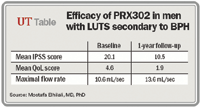Article
PSA-activated protoxin efficacious in BPH-related LUTS
A single injection of a bacterial protoxin can reduce lower urinary tract symptoms secondary to BPH and improve quality of life.

Key Points
San Francisco-A single injection of a bacterial protoxin can reduce lower urinary tract symptoms secondary to BPH and improve quality of life, the author of a Canadian multicenter phase II study from McGill University, Montreal, reported at the AUA annual meeting.
The agent, PRX302, led to statistically significant improvement in symptoms by 9.1 points on the International Prostate Symptom Score, compared with a 5.8-point reduction in the placebo group, said first author Mostafa Elhilali, MD, PhD, professor of surgery and chair of urology at McGill.
PRX302 creates a hole on the surface of a cell, but must be activated by PSA. Other cells are not damaged by the PRX302, and it's not toxic if absorbed into the blood. By targeting cells in patients with BPH, the agent results in ablation of prostatic tissue and symptom improvement for at least 1 year, as was previously demonstrated by a phase I study.

There was a dose-response effect, with patients receiving amounts equivalent to 20% or 30% of prostate volume having a more marked and sustained response. In addition, maximal flow rates, not studied in the phase I study, improved from 10.6 mL/sec at screening to 13.6 mL/sec at 1 year post-treatment.
No long-term adverse effects
The injection, administered transperineally with transrectal ultrasound guidance, had no long-term adverse effects, with only short-term increases in frequency and urgency due to the needle, not the medication, Dr. Elhilali said. There were no effects on erectile function.
"Since it's a single injection done in the office setting, it is a very attractive alternative therapy either as a first-line therapy or post-medical treatment failure option for patients," he said. "Patients very much appreciated the reduction in symptoms."
In general, the patients with the worst symptoms had the best improvements with the agent, Dr. Elhilali said. But to specifically identify what type of patient is best suited to treatment with PRX302, a much larger phase III study involving 600 to 700 patients would have to be conducted, he said.
A phase IIb double-blind randomized study of 94 patients is currently under way. The results at 3 months are quite encouraging, he noted, with the primary endpoint of symptom improvement being met. The data were presented at a late-breaking news session at the AUA meeting.
Implications for treating PCa
There are also implications for the use of PRX302 in focally treating prostate cancer.
"The studies that we have done so for are for BPH with symptoms, but one of our objectives is to also target prostate cancer in the future," Dr. Elhilali said. For BPH, the agent ablates prostatic tissue when injected into the transitional zone of the gland.
"But in prostate cancer, we just need to target the area that has the cancer without destroying the whole prostate."
This would require more sophisticated imaging and localization than is done for BPH, he added.
The studies of PRX302 are funded by Protox Therapeutics.
2 Commerce Drive
Cranbury, NJ 08512
All rights reserved.





